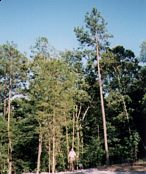
Our lot is called a "stove pipe lot" because it is set back from the street with a long driveway to it between the adjoining lots which are set on the street. (See the map - our lot is in red.) Because we have gotten so used to our privacy, when our neighbor wanted to sell their lot in 2012 (outlined in red on the map and north of the blue dot to about the top of the window in the aerial view below), we were happy to get it.
Here is a Google Earth aerial map with our house on it.
You can see the driveway coming from the cul de sac.
(Use the plus/minus keys on the left to zoom in/out.
Click and drag to pan around.)
View Larger Map
But before the trees were cleared, we called out an arborist from the state forestry service. At no charge to us, he spent a morning /identifying trees on our lot and making recommendations about what to cut down or keep. He even provided ribbon to tie around trees we wanted to save.
He also explained, as had others, that pine trees in our area cannot send down tap roots through the layer of shale lying beneath our top soil. So the pines tend to topple like dominoes around here. This is why builders will normally knock down all the pines before starting to build.
We hated to see some very large pine trees go, but we would have hated even worse to wake up one morning with a giant pine tree falling across our roof. We did leave some large pines at the bottom of our lot since they would not be a threat to our house.
Since most of the trees are very tall, an alternative to cutting them down to get a better view is to just cut off the lower limbs.
The arborist also explained that because tree roots cannot go down very far, they spread out quite a bit and are close to the surface. When buldozers and trucks keep running over the roots of remaining trees to get to the house, it can kill the trees.
The arborist suggest putting plastic fencing around the trees to protect the roots, but if we had done this, the house could not have been built since there were dozens of trees around the building area to protect, so all we could do was hope for the best.
[At Judy's house, we could have put fencing around the tress we wanted protected near the street, but didn't for reasons I don't remember. Maybe I didn't think there was any reason for anyone to be running over their roots, but what happened is that supplies and - worst of all - large piles of gravel and sand were dumped on their roots. This is not a good thing for the roots, and risks more damage from when a bulldozer blade is used to scoop up the materials. In addition, the electric company came through with a trenching tool and tore up some large roots needlessly, as well as completely knocking down some trees.]
Likewise, when they bulldozed the driveway, tree roots were chopped off and left sticking out of the ground all along the entire length of the driveway. Most of those trees seemed to have survived okay, but we have lost a few trees along the driveway, two in our driveway circle, and a few others out front, possibly due to some combination of the stress and some very hot, dry summers. A few of them were lost in the big ice storm that levelled trees all over the state a few years back.
But these trees have to go both because the workers need that space to be able to get equipment around the house to work on it and because after digging up tree roots that have grown into the house site area, the trees within 8' feet of the house would die anyway.
If at all possible, you should be present when the clearing is done so that you can point out which other trees on the lot to take down. In advance of that, you should get some ribbon and tie off the trees which you do not want cut down and/or which should go, and leave a note saying which is which.
Marking Your Territory:
Before construction begins, a survey of your lot will be done. Normally, the surveyor will mark the corners of any angles in your boundary with rebar driven into the ground. I recommend further marking of the boundary so that you will not have any trouble finding it in years to come.
At our house, I didn't do this and now have no idea where our meandering boudary line is. At Judy's, I used some PVC pipe left behind by a sprinkler system installer. I cut it in 2-foot lengths with a hacksaw, cutting at a 45-degree angle at one end so that I could drive it into the ground more easily.
I then used a rubber mallet to hammer the PVC down over the rebar the surveyor had used, as well as one or two points along the line between corners. By hammering it down to about 6"-8", the PVC will be easy to find when you are looking for it, but it should not be too obtrusive otherwise.